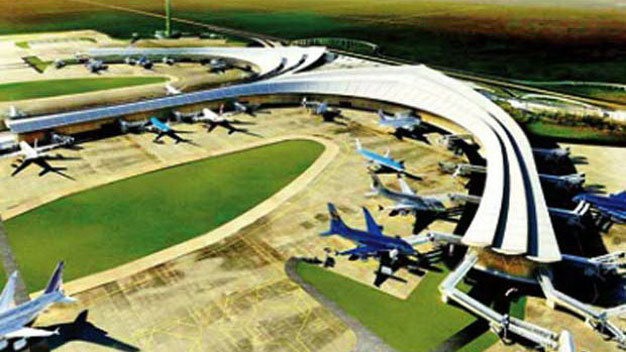NA discusses new airport, competition law
 |
| A drawing of the proposed Long Thành International Airport. - Photo chinhphu.vn |
The future airport, about 40km east of HCM City, is hoped to meet a big increase in demand for air travel. This has left the existing Tân Sơn Nhất Airport overloaded. The airport construction project is categorised as a key national project that needs the assembly’s approval.
According to a Government study delivered to the NA by newly-appointed Minister of Transport Nguyễn Văn Thể, the project will have a total land area of 5,585.14ha, covering six communes in Long Thành District. This excludes land for the construction of roads to the airport.
A total of 4,864 households with nearly 16,000 people and 26 organisations will be affected by the project.
The total investment for land acquirements, relocation and compensation payments is estimated at more than VNĐ23 trillion (about US$1.01 billion), of which VNĐ5 trillion has been approved by the NA.
The Government proposed the NA approve an additional fund of more than VNĐ18 trillion (US$792.64 million), taken from the State budget’s standby funds for public investment in mid and long-term.
A report by the NA’s Economic Committee, presented by chairman Vũ Hồng Thanh, said many deputies requested a careful verification to assure the correctness of the land area.
“Many deputies questioned the accuracy of the land area for residential living, estimated in the Government report to be only 35.64ha out of the total 5,585.14 ha,” the Economic Committee’s report said.
“They are worried that if the land area is not calculated correctly, it will result in a huge increase in compensation when the project is implemented.”
Deputies also want to redetermine the number of households needed to be relocated to other areas.
The Government study showed that all households that would lose their land to acquisition wanted new land for relocation.
However, out of 4,864 households affected, 534 will still retain part of their land. According to current regulations, if the remaining land is still big enough to build on, those households will not need to relocate, the report said.
On the relocation of a cemetery in the affected area, the Economic Committee suggested that public opinion be carefully guaged, especially religious establishments and religious people.
The committee agreed with the Government’s proposal that each household affected would also receive an additional amount equalling 4.5 times the regional minimum wage at the time of receiving support.
Speaking at a group discussion later, Deputy Hồ Văn Năm of Đồng Nai Province, where the project will be executed, said the Government should be careful about calculating the compensated land price.
“A big gap between the price rates determined by the State and the market will lead to discontent,” he said.
He said it was important to win public approval before acquiring the land, otherwise there would be misunderstanding among that could lead to public unrest.
Deputy Trương Trọng Nghĩa of HCM City asked for clarification of the land area for defence purpose in the project.
According to the Government’s project, 1,050ha out of more than 5,000ha of the project will be used for defence purpose.
Nghĩa said the Government and the NA should provide the public with detailed information on the need to have defence constructions built there, citing recent discoveries that much land for defence purpose in HCM City and other regions had been misused.
Competition Law
Also in the morning, NA deputies discussed the draft for a revised law on competition.
Many said that despite coming into effect in 2005, the law has been unaccommodating in practice and failed to tackle many competition cases.
Therefore, they said revision this time should take into consideration current situations in the market and business operation to come up with practical and feasible regulations.
Deputy Trần Hoàng Ngân from HCM City said in 2004 when the competition law was made, Việt Nam’s economy was not deeply integrated into regional and global economies.
During the 12 years that the law has existed, there were 80 investigations relating to the law.
“That’s why it is very necessary to have a revision of the law at this time,” he said.
“The drafting board needs to pay attention to contents relating to economic integration and international agreements that Việt Nam is participating to ensure fair competition and transparency among different economic sectors and business types,” he said.
Some deputies agreed with the Government proposal to merge the Việt Nam Competition Authority under the Ministry of Industry and Trade (MoIT) and the Việt Nam Competition Council into a new National Authority on Competition under MoIT.
However, others said that the new agency should be under the Government or the National Assembly to ensure independence and objectiveness.
Deputy Vũ Thị Lưu Mai of Hà Nội wondered about the possibility of a single authority to handle all competition-related cases, including many involving unfair competition. She suggested setting up agencies in charge of competition at localities, besides a national one.
What the stars mean:
★ Poor ★ ★ Promising ★★★ Good ★★★★ Very good ★★★★★ Exceptional
Latest News
More News
- Main drivers for Vietnam’s digital economy future (December 03, 2025 | 11:35)
- Pivotal stage of growth paves way for rise in M&As (December 03, 2025 | 10:00)
- Positive projections for M&A interest from Thailand (December 03, 2025 | 09:40)
- Manifesting the first line of defence in cybersecurity (December 03, 2025 | 09:00)
- The transformational role AI can play in accounting arena (December 03, 2025 | 08:00)
- Unlocking 5G-AI potential in Singapore (December 03, 2025 | 08:00)
- Data-driven strategies vital for a fast-evolving nation (December 02, 2025 | 09:41)
- Policy to practice: how Vietnam can lead the region (November 26, 2025 | 16:03)
- Mobilising private capital at scale vital for climate battle (November 26, 2025 | 15:36)
- VILAF and Yoon & Yang launch Vietnam - Korea Practice Unit (November 26, 2025 | 15:16)

















 Mobile Version
Mobile Version